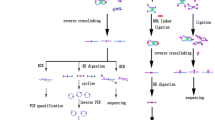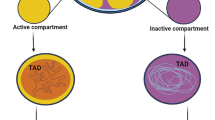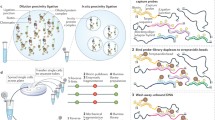Abstract
The chromosomes in eukaryotic cells are highly folded and organized to form dynamic three-dimensional (3D) structures. In recent years, many technologies including chromosome conformation capture (3C) and 3C-based technologies (Hi-C, ChIA-PET) have been developed to investigate the 3D structure of chromosomes. These technologies are enabling research on how gene regulatory events are affected by the 3D genome structure, which is increasingly implicated in the regulation of gene expression and cellular functions. Importantly, many diseases are associated with genetic variations, most of which are located in non-coding regions. However, it is difficult to determine the mechanisms by which these variations lead to diseases. With 3D genome technologies, we can now better determine the consequences of non-coding genome alterations via their impact on chromatin interactions and structures in cancer and other diseases. In this review, we introduce the various 3D genome technologies, with a focus on their application to cancer and disease research, as well as future developments to extend their utility.




Similar content being viewed by others
References
Ali T, Renkawitz R, Bartkuhn M. Insulators and domains of gene expression. Curr Opin Genet Dev. 2016;37:17–26. https://doi.org/10.1016/j.gde.2015.11.009.
Almassalha LM, et al. Macrogenomic engineering via modulation of the scaling of chromatin packing density. Nat Biomed Eng. 2017;1:902–13. https://doi.org/10.1038/s41551-017-0153-2.
Bailey JN, Pericak-Vance MA, Haines JL. The impact of the human genome project on complex disease. Genes. 2014;5:518–35. https://doi.org/10.3390/genes5030518.
Barutcu AR, et al. Chromatin interaction analysis reveals changes in small chromosome and telomere clustering between epithelial and breast cancer cells. Genome Biol. 2015;16:214. https://doi.org/10.1186/s13059-015-0768-0.
Beroukhim R, et al. The landscape of somatic copy-number alteration across human cancers. Nature. 2010;463:899–905. https://doi.org/10.1038/nature08822.
Bonev B, Cavalli G. Organization and function of the 3D genome. Nat Rev Genet. 2016;17:661–78. https://doi.org/10.1038/nrg.2016.112.
Buenrostro JD, Giresi PG, Zaba LC, Chang HY, Greenleaf WJ. Transposition of native chromatin for fast and sensitive epigenomic profiling of open chromatin, DNA-binding proteins and nucleosome position. Nat Methods. 2013;10:1213–8. https://doi.org/10.1038/nmeth.2688.
Chakraborty A, Ay F. Identification of copy number variations and translocations in cancer cells from Hi-C data. Bioinformatics. 2017; https://doi.org/10.1093/bioinformatics/btx664.
Chaudhary K, Chattopadhyay A, Pratap D. The evolution of CRISPR/Cas9 and their cousins: hope or hype? Biotechnol Lett. 2018;40:465–77. https://doi.org/10.1007/s10529-018-2506-7.
Chen X, et al. ATAC-see reveals the accessible genome by transposase-mediated imaging and sequencing. Nat Methods. 2016;13:1013–20. https://doi.org/10.1038/nmeth.4031.
Chen C, et al. Single-cell whole-genome analyses by linear amplification via transposon insertion (LIANTI). Science. 2017;356:189–94. https://doi.org/10.1126/science.aak9787.
Chin CS, et al. Nonhybrid, finished microbial genome assemblies from long-read SMRT sequencing data. Nat Methods. 2013;10:563–9. https://doi.org/10.1038/nmeth.2474.
Ciriello G, et al. Emerging landscape of oncogenic signatures across human cancers. Nat Genet. 2013;45:1127–33. https://doi.org/10.1038/ng.2762.
Crane E, et al. Condensin-driven remodelling of X chromosome topology during dosage compensation. Nature. 2015;523:240–4. https://doi.org/10.1038/nature14450.
Dekker J, Rippe K, Dekker M, Kleckner N. Capturing Chromosome Conformation. Science. 2002; https://doi.org/10.1126/science.1067799.
Dixon JR, et al. Topological domains in mammalian genomes identified by analysis of chromatin interactions. Nature. 2012;485:376–80. https://doi.org/10.1038/nature11082.
Dostie J, et al. Chromosome Conformation Capture Carbon Copy (5C): a massively parallel solution for mapping interactions between genomic elements. Genome Res. 2006;16:1299–309. https://doi.org/10.1101/gr.5571506.
Durand NC, et al. Juicebox provides a visualization system for Hi-C contact maps with unlimited zoom. Cell Syst. 2016;3:99–101. https://doi.org/10.1016/j.cels.2015.07.012.
Fairfax BP, et al. Innate immune activity conditions the effect of regulatory variants upon monocyte gene expression. Science. 2014;343:1246949. https://doi.org/10.1126/science.1246949.
Fang R, et al. Mapping of long-range chromatin interactions by proximity ligation-assisted ChIP-seq. Cell Res. 2016;26:1345–8. https://doi.org/10.1038/cr.2016.137.
Farh KK, et al. Genetic and epigenetic fine mapping of causal autoimmune disease variants. Nature. 2015;518:337–43. https://doi.org/10.1038/nature13835.
Flavahan WA, et al. Insulator dysfunction and oncogene activation in IDH mutant gliomas. Nature. 2016;529:110–4. https://doi.org/10.1038/nature16490.
Flyamer IM, et al. Single-nucleus Hi-C reveals unique chromatin reorganization at oocyte-to-zygote transition. Nature. 2017;544:110–4. https://doi.org/10.1038/nature21711.
Forbes SA, et al. COSMIC: exploring the world’s knowledge of somatic mutations in human cancer. Nucleic Acids Res. 2015;43:D805–11. https://doi.org/10.1093/nar/gku1075.
Franke M, et al. Formation of new chromatin domains determines pathogenicity of genomic duplications. Nature. 2016;538:265–9. https://doi.org/10.1038/nature19800.
Fullwood MJ, et al. An oestrogen-receptor-alpha-bound human chromatin interactome. Nature. 2009;462:58–64. https://doi.org/10.1038/nature08497.
Garraway LA, Lander ES. Lessons from the cancer genome. Cell. 2013;153:17–37. https://doi.org/10.1016/j.cell.2013.03.002.
Gibcus JH, Dekker J. The hierarchy of the 3D genome. Mol Cell. 2013;49:773–82. https://doi.org/10.1016/j.molcel.2013.02.011.
Gilley D, Tanaka H, Herbert BS. Telomere dysfunction in aging and cancer. Int J Biochem Cell Biol. 2005;37:1000–13. https://doi.org/10.1016/j.biocel.2004.09.003.
Hnisz D, et al. Activation of proto-oncogenes by disruption of chromosome neighborhoods. Science. 2016;351:1454–8. https://doi.org/10.1126/science.aad9024.
Hsieh TH, et al. Mapping nucleosome resolution chromosome folding in yeast by micro-C. Cell. 2015;162:108–19. https://doi.org/10.1016/j.cell.2015.05.048.
Hu M, et al. HiCNorm: removing biases in Hi-C data via Poisson regression. Bioinformatics. 2012;28:3131–3. https://doi.org/10.1093/bioinformatics/bts570.
Huang H, Wu Q. CRISPR double cutting through the labyrinthine architecture of 3D genomes. J Genet Genomics. 2016;43:273–88. https://doi.org/10.1016/j.jgg.2016.03.006.
Hughes JR, et al. Analysis of hundreds of cis-regulatory landscapes at high resolution in a single, high-throughput experiment. Nat Genet. 2014;46:205–12. https://doi.org/10.1038/ng.2871.
Kandoth C, et al. Mutational landscape and significance across 12 major cancer types. Nature. 2013;502:333–9. https://doi.org/10.1038/nature12634.
Kolovos P, van de Werken HJG, Kepper N, Zuin J, Brouwer RWW, Kockx CEM, et al. Targeted chromatin capture (T2C): a novel high resolution high throughput method to detect genomic interactions and regulatory elements. Epigenetics Chromatin. 2014;7:10. https://doi.org/10.1186/1756-8935-7-10.
Lewis TE, et al. Genome3D: exploiting structure to help users understand their sequences. Nucleic Acids Res. 2015;43:D382–6. https://doi.org/10.1093/nar/gku973.
Li W, Gong K, Li Q, Alber F, Zhou XJ. Hi-corrector: a fast, scalable and memory-efficient package for normalizing large-scale hi-C data. Bioinformatics. 2015;31:960–2. https://doi.org/10.1093/bioinformatics/btu747.
Li R, Liu Y, Li T, Li C. 3Disease browser: a web server for integrating 3D genome and disease-associated chromosome rearrangement data. Sci Rep. 2016;6:34651. https://doi.org/10.1038/srep34651.
Li Z, Chen J, Yu H, He L, Xu Y, Zhang D, et al. Genome-wide association analysis identifies 30 new susceptibility loci for schizophrenia. Nat Genet. 2017;49(11):1576-1583. https://doi.org/10.1038/ng.3973.
Liang Z, et al. BL-Hi-C is an efficient and sensitive approach for capturing structural and regulatory chromatin interactions. Nat Commun. 2017;8:1622. https://doi.org/10.1038/s41467-017-01754-3.
Lieberman-Aiden E, et al. Comprehensive mapping of long-range interactions reveals folding principles of the human genome. Science. 2009;326:289–93. https://doi.org/10.1126/science.1181369.
Lupianez DG, et al. Disruptions of topological chromatin domains cause pathogenic rewiring of gene-enhancer interactions. Cell. 2015;161:1012–25. https://doi.org/10.1016/j.cell.2015.04.004.
Ma W, et al. Fine-scale chromatin interaction maps reveal the cis-regulatory landscape of human lincRNA genes. Nat Methods. 2015;12:71–8. https://doi.org/10.1038/nmeth.3205.
Martin P, et al. Capture Hi-C reveals novel candidate genes and complex long-range interactions with related autoimmune risk loci. Nat Commun. 2015;6:10069. https://doi.org/10.1038/ncomms10069.
Mieczkowski J, et al. MNase titration reveals differences between nucleosome occupancy and chromatin accessibility. Nat Commun. 2016;7:11485. https://doi.org/10.1038/ncomms11485.
Mifsud B, Tavares-Cadete F, Young AN. Mapping long-range promoter contacts in human cells with high-resolution capture Hi-C. Nat Genet. 2015; https://doi.org/10.1038/ng.3286.
Mumbach MR, et al. HiChIP: efficient and sensitive analysis of protein-directed genome architecture. Nat Methods. 2016; https://doi.org/10.1038/nmeth.3999.
Nagano T, et al. Single-cell Hi-C reveals cell-to-cell variability in chromosome structure. Nature. 2013;502:59–64. https://doi.org/10.1038/nature12593.
Nagano T, et al. Single-cell Hi-C for genome-wide detection of chromatin interactions that occur simultaneously in a single cell. Nat Protoc. 2015;10:1986–2003. https://doi.org/10.1038/nprot.2015.127.
Nagano T, et al. Cell-cycle dynamics of chromosomal organization at single-cell resolution. Nature. 2017;547:61–7. https://doi.org/10.1038/nature23001.
Naumova N, Dekker J. Integrating one-dimensional and three-dimensional maps of genomes. J Cell Sci. 2010;123:1979–88. https://doi.org/10.1242/jcs.051631.
Nora EP, et al. Spatial partitioning of the regulatory landscape of the X-inactivation centre. Nature. 2012;485:381–5. https://doi.org/10.1038/nature11049.
Northcott PA, et al. Enhancer hijacking activates GFI1 family oncogenes in medulloblastoma. Nature. 2014;511:428–34. https://doi.org/10.1038/nature13379.
Nowotny J, et al. GMOL: an interactive tool for 3D genome structure visualization. Sci Rep. 2016;6:20802. https://doi.org/10.1038/srep20802.
Paulsen J, et al. HiBrowse: multi-purpose statistical analysis of genome-wide chromatin 3D organization. Bioinformatics. 2014;30:1620–2. https://doi.org/10.1093/bioinformatics/btu082.
Ramani V, et al. Massively multiplex single-cell Hi-C. Nat Methods. 2017; https://doi.org/10.1038/nmeth.4155.
Rao SS, et al. A 3D map of the human genome at kilobase resolution reveals principles of chromatin looping. Cell. 2014;159:1665–80. https://doi.org/10.1016/j.cell.2014.11.021.
Sachdeva M, et al. CRISPR/Cas9: molecular tool for gene therapy to target genome and epigenome in the treatment of lung cancer. Cancer Gene Ther. 2015;22:509–17. https://doi.org/10.1038/cgt.2015.54.
Sandve GK, et al. The Genomic HyperBrowser: inferential genomics at the sequence level. Genome Biol. 2010;11:R121. https://doi.org/10.1186/gb-2010-11-12-r121.
Sato T, Suyama M. ChromContact: a web tool for analyzing spatial contact of chromosomes from Hi-C data. BMC Genomics. 2015;16:1060. https://doi.org/10.1186/s12864-015-2282-x.
Seaman L, et al. Nucleome analysis reveals structure-function relationships for colon cancer. Mol Cancer Res. 2017;15:821–30. https://doi.org/10.1158/1541-7786.MCR-16-0374.
Serra F, et al. Automatic analysis and 3D-modelling of Hi-C data using TADbit reveals structural features of the fly chromatin colors. PLoS Comput Biol. 2017;13:e1005665. https://doi.org/10.1371/journal.pcbi.1005665.
Servant N, et al. HiC-Pro: an optimized and flexible pipeline for Hi-C data processing. Genome Biol. 2015;16:259. https://doi.org/10.1186/s13059-015-0831-x.
Shrivastav M, De Haro LP, Nickoloff JA. Regulation of DNA double-strand break repair pathway choice. Cell Res. 2008;18:134–47. https://doi.org/10.1038/cr.2007.111.
Simonis M, et al. Nuclear organization of active and inactive chromatin domains uncovered by chromosome conformation capture-on-chip (4C). Nat Genet. 2006;38:1348–54. https://doi.org/10.1038/ng1896.
Song, L. & Crawford, G. E. DNase-seq: a high-resolution technique for mapping active gene regulatory elements across the genome from mammalian cells. Cold Spring Harb Protoc. 2010. https://doi.org/10.1101/pdb.prot5384.
Stevens TJ, et al. 3D structures of individual mammalian genomes studied by single-cell Hi-C. Nature. 2017;544:59–64. https://doi.org/10.1038/nature21429.
Taberlay PC, et al. Three-dimensional disorganisation of the cancer genome occurs coincident with long range genetic and epigenetic alterations. Genome Res. 2016; https://doi.org/10.1101/gr.201517.115.
Tang Z, et al. CTCF-mediated human 3D genome architecture reveals chromatin topology for transcription. Cell. 2015;163:1611–27. https://doi.org/10.1016/j.cell.2015.11.024.
Teng L, He B, Wang J, Tan K. 4DGenome: a comprehensive database of chromatin interactions. Bioinformatics. 2015;31:2560–4. https://doi.org/10.1093/bioinformatics/btv158.
Tomczak K, Czerwinska P, Wiznerowicz M. The cancer genome atlas (TCGA): an immeasurable source of knowledge. Contemp Oncol (Pozn). 2015;19:A68–77. https://doi.org/10.5114/wo.2014.47136.
Van de Werken HJ, et al. Robust 4C-seq data analysis to screen for regulatory DNA interactions. Nat Methods. 2012;9:969–72. https://doi.org/10.1038/nmeth.2173.
Vietri Rudan M, et al. Comparative Hi-C reveals that CTCF underlies evolution of chromosomal domain architecture. Cell Rep. 2015;10:1297–309. https://doi.org/10.1016/j.celrep.2015.02.004.
Weischenfeldt J, et al. Pan-cancer analysis of somatic copy-number alterations implicates IRS4 and IGF2 in enhancer hijacking. Nat Genet. 2017;49:65–74. https://doi.org/10.1038/ng.3722.
Wingett S, et al. HiCUP: pipeline for mapping and processing Hi-C data. F1000Research. 2015;4:1310. https://doi.org/10.12688/f1000research.7334.1.
Wu P, et al. 3D genome of multiple myeloma reveals spatial genome disorganization associated with copy number variations. Nat Commun. 2017;8:1937. https://doi.org/10.1038/s41467-017-01793-w.
Xu Z, et al. HiView: an integrative genome browser to leverage Hi-C results for the interpretation of GWAS variants. BMC Res Notes. 2016;9:159. https://doi.org/10.1186/s13104-016-1947-0.
Yaffe E, Tanay A. Probabilistic modeling of Hi-C contact maps eliminates systematic biases to characterize global chromosomal architecture. Nat Genet. 2011;43:1059–65. https://doi.org/10.1038/ng.947.
Zack TI, et al. Pan-cancer patterns of somatic copy number alteration. Nat Genet. 2013;45:1134–40. https://doi.org/10.1038/ng.2760.
Zhou X, et al. Exploring long-range genome interactions using the WashU Epigenome Browser. Nat Methods. 2013;10:375–6. https://doi.org/10.1038/nmeth.2440.
Acknowledgements
This work was supported by funding from Peking-Tsinghua Center for Life Sciences, School of Life Sciences and Center for Statistical Science of Peking University, National Natural Science Foundation of China Key Research Grant 71532001, and Chinese National Key Projects of Research and Development (2016YFA0100103). We are grateful to Ming Du for his assistance with figures.
Author information
Authors and Affiliations
Contributions
Ruifeng Li designed and supervised this review. Yingping Hou was responsible for the section on 3D genome technology and novel findings. Yuting Liu and Pengze Wu was responsible for the section on 3D genome reorganization in cancer and clinical applications. Ruifeng Li was responsible for the section on 3D genome reorganization in other diseases. Jingbo Gan was responsible for the section on single cell Hi-C and future directions. C.L. participated in writing.




